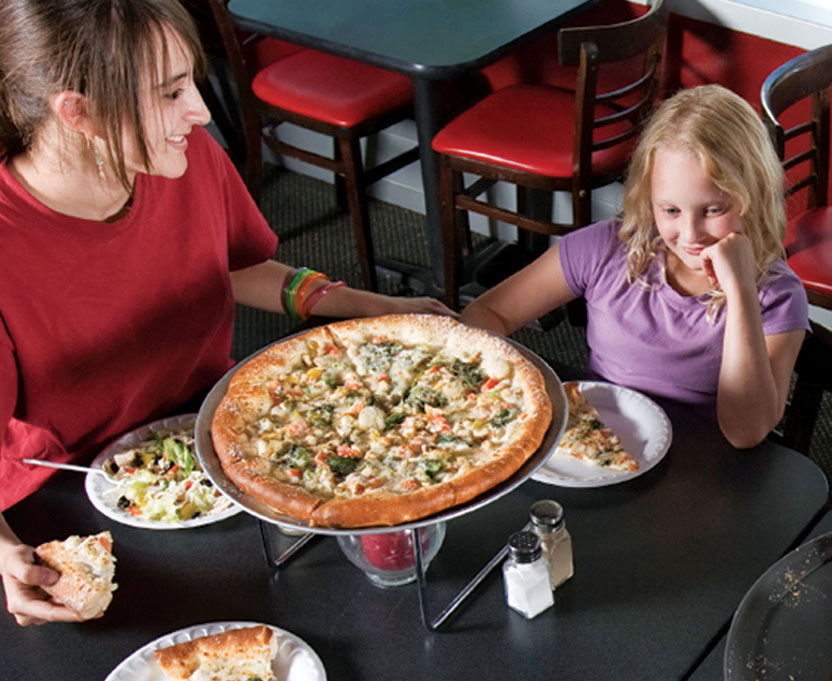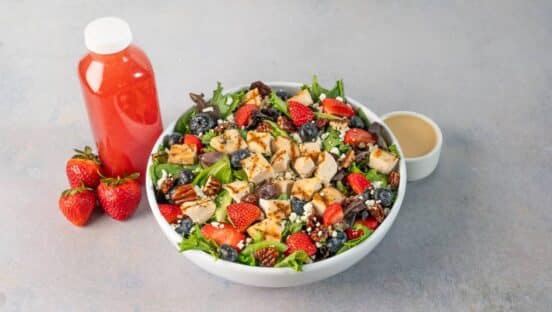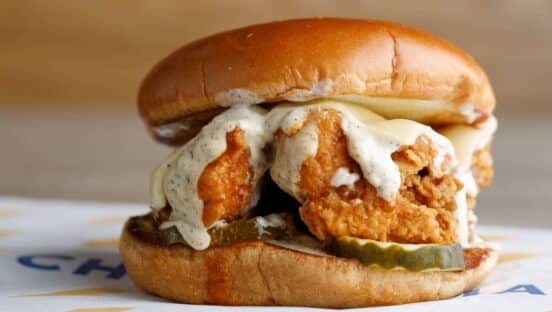It’s a given that most American kids love pizza, burgers, tacos, hot dogs, chicken fingers, and grilled cheese sandwiches.
Many of these are also the types of food that can come under fire from parents and nutritional experts who worry about what kids are eating, particularly considering the growing problem of childhood obesity and other related illnesses.
The interest by restaurant operators and chefs in serving better-for-you kids’ menu items, for both business reasons and true concern about what children are eating, is one reason kids’ nutrition was projected to be a major trend at dining establishments this year.
The National Restaurant Association’s (NRA) annual “What’s Hot” survey of 1,800 professional chefs from the American Culinary Federation determined that healthful meals for young people would be the No. 3 trend for the industry this year.
Not surprisingly, an increasing number of quick-service and fast-casual restaurants are coming up with various kids’ meals that are lower in calories, salt, and fat and higher in important nutrition density.
One of the biggest efforts to improve the healthful nature of children’s food when eating out is the NRA’s Kids LiveWell initiative, which launched about a year ago in collaboration with San Diego–based nutrition firm Healthy Dining. The program began with 19 restaurant brands and has grown to nearly 100, representing more than 25,000 restaurants in all 50 states. It also includes one non-operating company, Kraft Foods Inc.
Participation in the initiative “has exploded in a short period of time,” says NRA president and CEO Dawn Sweeney, who announced the expansion at the organization’s annual industry show in Chicago in May.
“We’re encouraged by the excitement and the momentum” of the program, which is giving parents a growing selection of healthful children’s menu options, including lean protein, fruit and vegetables, whole grains, and low-fat dairy products, she says.
Companies that join the Kids LiveWell program must offer and promote items that meet qualifying nutrition criteria based on top health organizations’ recommendations. Kids’ meals must contain fewer than 600 calories and at least two food groups.
The plan received praise at the NRA show from former President Bill Clinton.
“I came here to thank you for all that’s being done through your initiative to help our kids get healthier,” Clinton said during his keynote address. He also lauded the program for its ability to get a variety of different entities to work together.
Making fruits, vegetables, low-fat milk, and fruit juice part of a kids’ meal helps parents, not just by having the items available, but also by offering them as the default option, meaning healthy food is built into the meal. It’s sort of a stealth-health approach.
“For years, you had to ask to get a salad or fruit instead of french fries, and that puts the onus on me to choose them,” says Pamela Smith, an Orlando, Florida, nutritionist, author, consultant, and energy coach. “But if I can bundle the healthier choices, that’s best.”
It also prevents food fights between parents who want a healthier option and kids who want fun foods that may be high in sodium and sugar.
Anita Shaffer, director of menu management for Chartwells School Dining Services in Rye Brook, New York, confirms that healthy choices as the default is best.
“Why not make healthy options the default, and the less nutritious items the ones that have to be chosen?” she says. “You may be surprised that kids love the healthy ones.”
The NPD Group, a consulting and market research firm, projected that fruit, mini burgers, grilled and baked chicken, and noncarbonated drinks would grow in popularity this year and beyond.
The number of visits at quick serves by families with kids was flat in 2011 for the second consecutive year after several years of declines, but only 8 percent of quick-service restaurant visits of groups with children include a kids’ meal or order from a kids’ menu, according to the NPD Group.
“The price for the kids’ meals have been going up, and that is part of it,” says Bonnie Riggs, NPD’s restaurant industry analyst. “There’s been a lot of switching from the kids’ meals to the value menu, and splitting some of those items among the kids.”
While the kids’ meals with toys appeal to children aged 4 and younger, kids older than that “want choices,” Riggs notes. Children and their parents increasingly are seeking food that is fresh, flavorful, and healthful, but they still want to indulge when dining out.
“Behavior is changing, but slowly,” she says.
Part of that is because kids’ preferences are American-made.
“Around the world, kids are eating black beans, rice, fish, hummus, pita bread, and other foods,” nutritionist Smith says. Defining a restaurant’s food as healthy “is like the kiss of death” in the view of many, because that type of food had little or no taste years ago.
“The real challenge is to develop dishes that aren’t labeled healthy, but are nutritious and delicious,” she says. “We want to give kids the nutrients they need to grow and play and think and have fun, but with an eye on controlling calories.”
Changes in children’s tastes, especially to more healthful options, are showing up in school menus, which often reflect the popular quick-serve options, Shaffer says.
“We get inspiration from quick-service restaurants because children are exposed to them and those preferences,” she says. “We take popular foods and enhance the nutritional value.”
The idea is to give kids what they know and like, but make a few tweaks here and there to make it healthier.
For instance, Chartwells has a proprietary pizza crust made with whole-wheat flour, flax, and olive oil. “We top it with low-fat cheese, and then there are plenty of toppings, including all kinds of vegetables, the kinds of foods kids should eat more of,” Shaffer says.
Shaffer has also seen students gravitate toward other healthier items, including baked (not fried) chicken, flavorful and spicy sauces, and sub sandwiches made with lower-fat meats and cheeses, numerous vegetables, and whole-grain breads.
[pagebreak]
One of the originators of kids’ meals, McDonald’s, is a long-time favorite for kids—and a target for critics due to that.
Last year, responding to mounting pressure from parents, nutritional experts, and others, the company set new goals to reduce sodium, sugar, and saturated fat in its menu. Happy Meals, which originally launched in 1979, were changed to include fruit and half the french fries as before.
The Happy Meals, with hamburger, cheeseburger, or four-piece Chicken McNuggets, also include fat-free chocolate milk, low-fat white milk, or apple juice, although soda is an option parents can choose. The meals have fewer than 600 calories.
The chain also launched an ad campaign called “Champions of Play,” which celebrates active lifestyles and healthy, balanced eating by kids.
“We are seeing behavior shift slightly among what is being ordered, because families are eating differently than they used to when they go out,” says spokeswoman Danya Proud.
“They may order a Happy Meal because kids love the specialness of their own meal, or they may share Chicken McNuggets, fries, and then get their own drinks.”
McDonald’s is not part of Kids LiveWell, but many other independent and chain restaurants that offer healthier menu items—dubbed better-for-you because of the negative connotation of healthy—joined the initiative.
A few companies had to tweak their items to qualify for the program. Others, such as Burger King, did not.
Several Burger King offerings that met the initiative’s criteria were the burger, four-piece chicken tenders, and BK Kids Breakfast Muffin Sandwich kids’ meals. The meals also have Apple Fries (apple pieces in the shape of fries) and a choice of fat-free milk or apple juice.
Zpizza’s range of better-for-you items for adults can also meet the Kids LiveWell criteria. The pizzas are on the regular menu, and the child’s portion is two slices of pizza, plus a salad (no dressing) and water as the beverage.
“Kids love cheese pizza,” says Brandi Babb, vice president of training and franchise relations for the Irvine, California–based chain. “Our mozzarella is part skim and doesn’t have any added hormones, so we are proud to be able to serve this” to children.
The chain’s Kids LiveWell pizza offerings feature a variety of fresh vegetables, including one with roasted yams. That particular pizza also has all-natural chicken breast.
Zpizza is looking to add additional Kids LiveWell menu items. “We see a great opportunity in this program and look forward to growing it,” Babb says.
Canada-based Extreme Pita had already made some menu alterations to meet that nation’s Health Check program before joining the NRA’s initiative.
“Our brand is all about healthy,” says Nancy Cogger, director of marketing for the chain, which has 200 units in the U.S. and Canada. “For Health Check, we had to work on our sodium levels, which is a big contributor of making things taste good, but we did it.”
The children’s meals have fun names like Beefosaurus Rex Pita (Philly steak) and Fee-Fi-Fo-Hummus Pita, which include baked pita chips and water.
Chick-fil-A is among the most recent chains to join Kids LiveWell. The company introduced grilled chicken nuggets in January as an option for its kids’ meals, which also include Buddy Fruits applesauce and milk or lemonade as a beverage.
“We’ve had hand-breaded [chicken] nuggets for years,” says Jodie Worrell, senior nutrition consultant for the Atlanta-based company. They remain on the menu, but the grilled nuggets reduce fat by 86 percent and calories by 56 percent.
“We want parents to know that they do have a choice,” she adds.
It’s not just big companies looking to give parents the tools to get their kids to eat better when dining out. Take the Solar Drive-In, a small eatery in Springfield, Minnesota.
“I’m personally concerned about seeing the way kids eat,” says Deanne Bryer, who with her husband, Steve, and son, Luke, acquired the local eatery in 2008. “I was looking for a way to have a choice for parents without hitting them over the head.”
Working with Kids LiveWell provided the answer, allowing the company to work with the program’s nutritional experts they normally couldn’t afford. The healthy children’s offerings include grilled chicken bites and a flour chicken taco. The suggested side is carrots and celery.
“We had a sautéed chicken breast on the menu, and some moms would buy it without the bun and ask us to cut it up for the kids. The nutritionist said that would work,” Bryer says. “We previously had a chicken taco, so we modified the size” to meet initiative guidelines.
Kraft developed its Kids LiveWell menu items for all types of restaurants shortly after the program was announced.
“We met with our chef and our nutrition experts and looked at the nutrition criteria and asked, ‘Is this realistic for Kraft?’” explains Barbara Pritikin, senior marketing manager. It turned out that “we had the products in our portfolio” to provide solutions for restaurants.
Nine Kraft brands are used in the company’s eight kids’ meals, such as a turkey burger and strawberries or macaroni and cheese stuffed chicken with broccoli and strawberries. The beverage is a Capri Sun fruit drink, also part of the Kraft production family.
“It really comes down to the offerings on the menu,” Pritikin says. “That’s what parents are looking for.”











